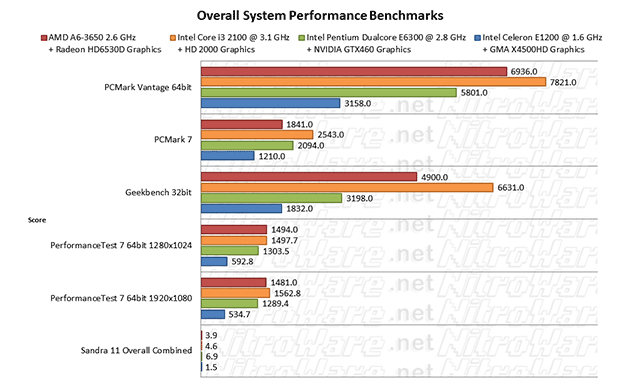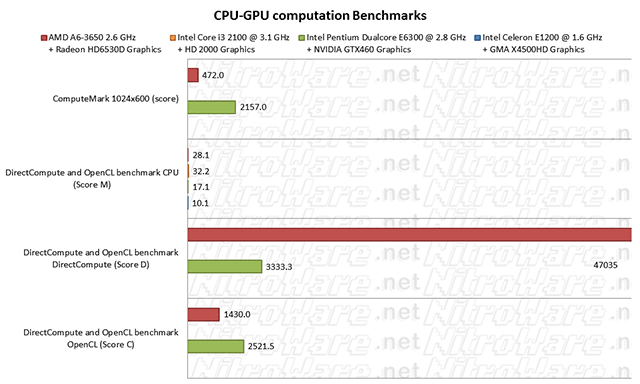System Benchmarks
Windows 7 Experience Index
Windows 7 includes a built set of benchmarks to allow the typical user to simply and easily gauge the overall performance of their PC or any prospective PC purchase running Windows 7, the higher the better. Many 'experts' brush off these tests as a gimmick, however these scores are not guesstimated by Windows, the user simply does not see the benchmarks run when the assessment is run. Advanced users can run these tests from Windows Command Prompt and will see the actual tests run and the source media used for these benchmarks. The AMD A6 system offers a better balanced overall system performance than the INTEL i3.

Although not part of the round up used in this review, the Intel i5-2300 (base 2.8GHz, Turbo 3.1GHz) with HD2000 Graphics, 4GB of DDR3-1333 RAM and 1TB hard disk achieves WEI scores of 7.4, 5.9, 5.1, 5.8, and 5.9. The graphics scores were of graphics drivers available at Sandy Bridge launch of Jan 2011.
At 1.5 times the price of the Intel i3 and AMD A6, when looking at overall and balanced performance, the Intel 2nd generation i5 does not provide a significant boost in overall system performance and certainly not 1.5x the overall system performance if we use the integrated graphics for Windows 7's built in benchmarks.
WEI is not a definitive benchmark of performance but it is a good, relevant and accurate one.
The situation is different with real applications rather than Windows 7's WEI as the 3.3GHz Intel 2nd Generation i5-2500K with its HD3000 graphics and whopping 3.7GHz turbo speed is able to almost double the i3-2100s's game frames in Dirt2, Just Cause 2 and other popular games such as Batman and Call of Duty at Medium resolutions using the Intel graphics. However, the i5-2500K is a performance oriented CPU priced at $220, $40 more than the i5-2300 and $100 more than the i3-2100. You get what you pay for.
Overall System Performance Benchmarks
The following benchmarks test each individual subsystem of a PC using different tests that represent applications used on a day-to-day basis. Math, 2D and 3D Graphics, Video playback and conversion, disk and memory performance, internet, web and networking, multi-tasking and GPU accelerated physics are all taken into consideration to generate sub scores and a total score representing the performance of a particular PC. Many of these suites actually overlap in the tests they perform, however all of these are Industry standard and no two have exactly the same tests, some of these programs have tests the others do not so we have included all of them rather than relying on just PCMark or SANDRA for example.
"PCMark Vantage is the first objective hardware performance benchmark for PCs running Windows 7 or Windows Vista. From desktops and laptops to workstations and gaming rigs, PCMark Vantage helps you find the hardware and software bottlenecks that stop you getting more from your PC."
"PCMark 7 includes 7 PC tests for Windows 7, combining more than 25 individual workloads covering storage, computation, image and video manipulation, web browsing and gaming. Specifically designed to cover the full range of PC hardware from netbooks and tablets to notebooks and desktops, PCMark 7 offers complete PC performance testing for Windows 7 for home and business use."
http://www.futuremark.com/benchmarks/
The i3 is faster in Futuremark PCMark and Geekbench simply due to its higher clock speed and optimisations while Passmark PerformanceTest shows the AMD and INTEL systems equal These tests are more CPU than GPU biased so the faster CPU will win.
We note that PerformanceTest has a very high margin of error and deviance and is extremely dependant on the system preferences. If user turns off graphical effects for the desktop a higher score is possible, Additionally PerformanceMark does not have a default recommended resolution. PCMark turns Windows Aero off by default and has a default resolution. Remember we are testing an AMD A6, not the A8 that is faster. Unofficially the A8 is about 20% faster than the A6 that would narrow or change the outcome of some tests.

Software Installation and Math calculation
Software installation can be a frustrating 'cup of coffee' experience for some users especially with older PCs, however modern PCs install and uninstall software quite swiftly thanks to fast CPU, memory and disk systems.
We downloaded the full offline installation package for Adobe Acrobat Reader 10.1, Apple iTunes + QuickTime 10.4 and Microsoft Live Essentials 2011. We executed a command to force Windows to finish executing any current tasks and to go to an idle state. We then manually timed the installation processes for each application using a stopwatch from the first dialog box to appear to the final 'done' dialog box. We repeated the test several times to achieve consistent results and took an average.
Both the AMD and INTEL 2011 systems over excellent performance to install popular applications with the very large 210 megabyte Microsoft Live Essentials Package taking just over one and a half minutes on both 2011 systems
HyperPi 0.99 and wPrime 2.05 are two popular tools used to calculate 'pi' to a selectable number of decimal places. The faster the CPU, the lower the time.
HyperPi simply executes one instance of HyperPi on each CPU core, e.g. 2, 4, 6 cores. It then averages the timed results across each core. This test determines the speed of the processor by testing each core on an equal basis for single-threaded performance.
wPrime divides the workload to calculate Pi across the number of CPU cores, making better use of multiple CPU cores.
The HyperPi results reflect what we noticed earlier with the relatively mildly clocked AMD A6 losing out in CPU-bound tests, it needs a higher clock speed to compete. However, our mildly clocked quad core A6 beats out the high-clocked dual core in wPrime.
.
File Archiving and CPU-GPU computation
The popular and common file archiving tools 7-Zip 9.22 64bit and WinRAR 4.01 64bit both have built in benchmarks to determine the overall throughput both tools can achieve, excluding the disk used. A hard disk drive is usually the bottleneck when creating or extracting archive files.
We could have archived a group of files and timed this however the result will not be replicable by readers in a consistent fashion as the tests are disk and file system dependant as we said. By using the built in tests, which are influenced by CPU and Memory this gives a more consistent result. Note that the results are flipped between the two programs, showing the affect good software design and optimisation has on system performance.
ComputeMark 2.1 by Robert Vargas is a DirectX11 compute shader benchmark featuring Fluid simulation, Mandelbrot sets and Ray Tracing on systems. PCs with DirectX11 class graphics will support a feature called direct Compute, which all allow tasks to be completed by the combined efforts of the CPU and the DirectX11 GPU. We used the default settings.
Only the AMD A6 system and the Core2duo with NVIDIA GTX460 were able to complete this test, where the performance class oriented GTX460 is much faster than the mainstream/mid-level Radeon 6530 GPU in the AMD A6 APU.
Neither the HD2000 Graphics nor the X4500HD graphics support OpenCL or DirectCompute acceleration, as they are DirectX10 compatible only.
DirectCompute and OpenCL benchmark v0.45 by Patryk Dabrowski is a similar test to Computemark except that it offers more configuration and test options.
For DirectCompute and OpenCL test executed on the CPU, only both 2011 systems offer similar performance as the test does not use the GPU to offload processing.
For DirectCompute tests, since the AMD 'Fusion' architecture enables the CPU and GPU both to be seen to Windows as available to be used for DirectCompute acceleration, Whereas the NVIDIA system only has one DirectCompute/OpenCL device available - the graphics card itself, the AMD A6 system achieves an off the scale result. DirectCompute allows both the CPU and GPU can work together to accelerate computation. Fusion incorporates some enhancements to speed up communication between the CPU and GPU such as 'Zero Copy', which allows contents of CPU and GPU memory to be accessed faster than if the memory, was access.
The Radeon graphics in 'Fusion' is more suited to certain computations by design by NVIDIA plus the tightly coupled pairing of CPU, GPU and memory give it the edge. A case of tortoise and the hare perhaps.
GPU acceleration of certain tasks is only a relativity new concept and is limited by the available software just as the smartphone and tablet market is driven by the availability of applications for each device. OpenCL and DirectCompute (DirectX 11) software technologies enable the acceleration of software by graphics hardware which is optimised to perform multiple computations at once, dubbed parallel processing
Areas for which Parallel computing/GPU computing is strongly beneficial include
- Consumer multimedia and web
- Computer-Aided Engineering
- Digital Content Creation
- Digital Security
- Financial Modelling and Risk Analysis
- Graphics Rendering
- Medical Imaging
- Oil & Gas Exploration
- Physics for gaming and simulations
- Professional Video
- Scientific Research
As far as our off the scale result for DirectCompute with the A6 is concerned. AMD cite the A6 as having up to 284 gigaflops of compute performance and the more expensive A8 has 480 gigaflops of compute performance, significant difference however that is just what $150 buys. The May 2011 release of AMD's flagship (and relatively expensive) Radeon HD 6990 has 5.1 teraflops (5100 gigaflops) according to AMD.
Ten years prior, such performance was the realm of supercomputers as reported by supercomputer leader board site top500.org
November 2002 "3.2 TFlops are needed to enter the top 10" http://www.top500.org/lists/2002/11
November 2000 "ASCI White is new #1 with 4.9 TFlops in Linpack" http://www.top500.org/lists/2000/11
The compute capability of one quarter to half a teraflops with a $150 processor can be classified as a "personal supercomputer"